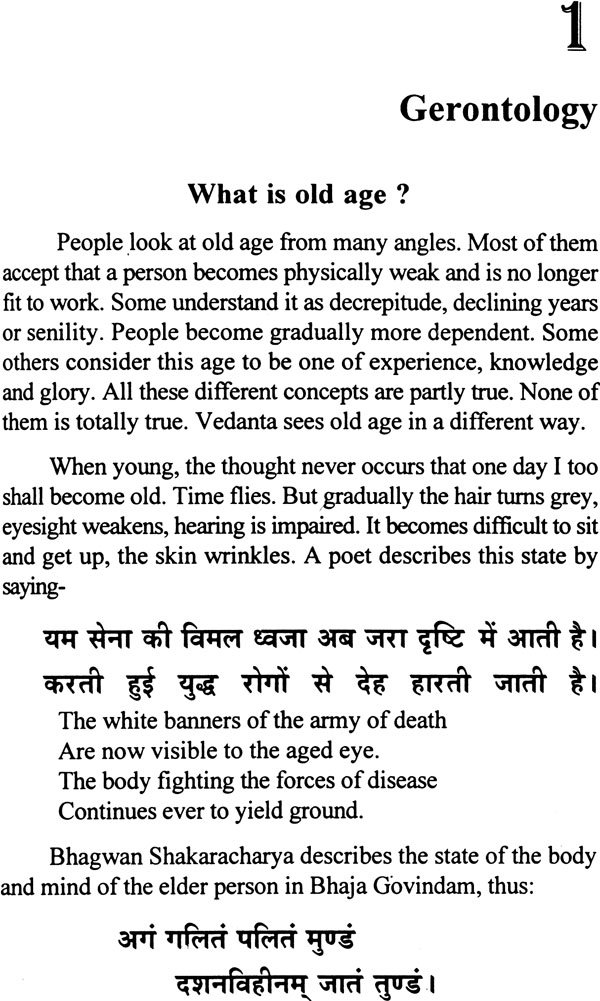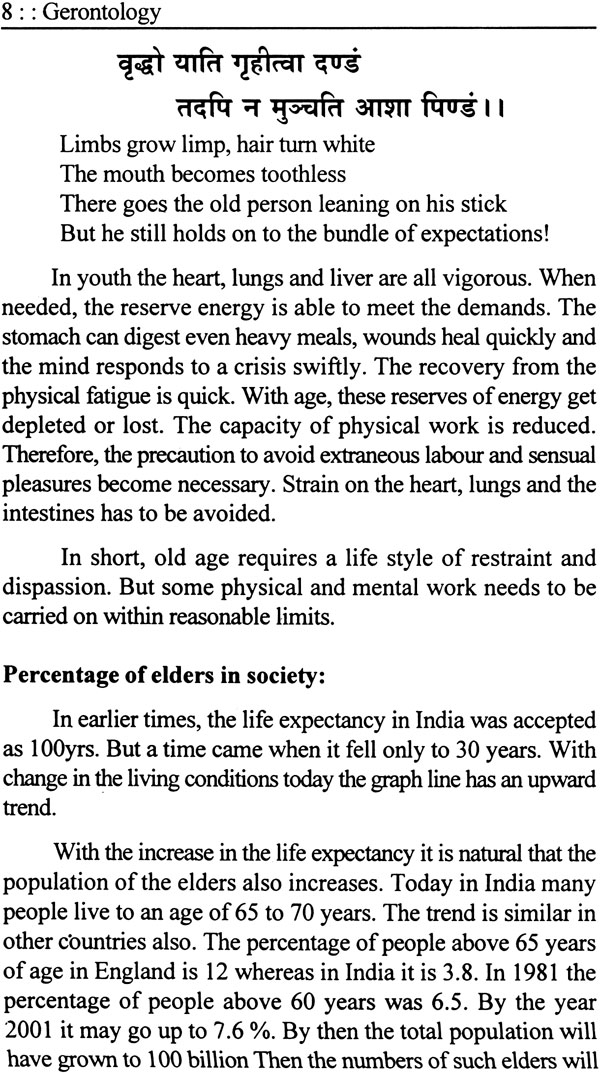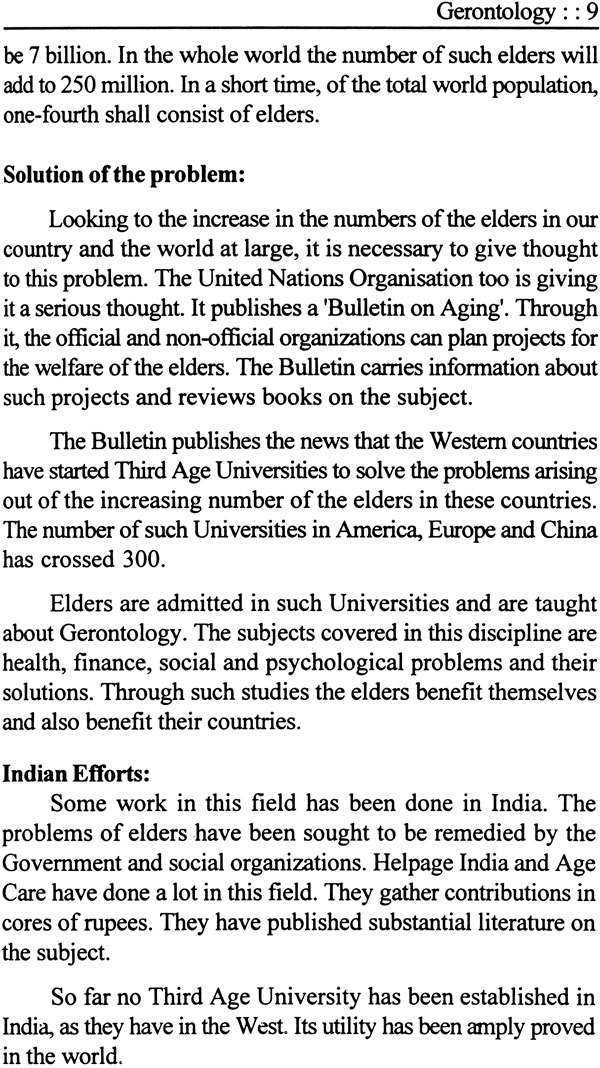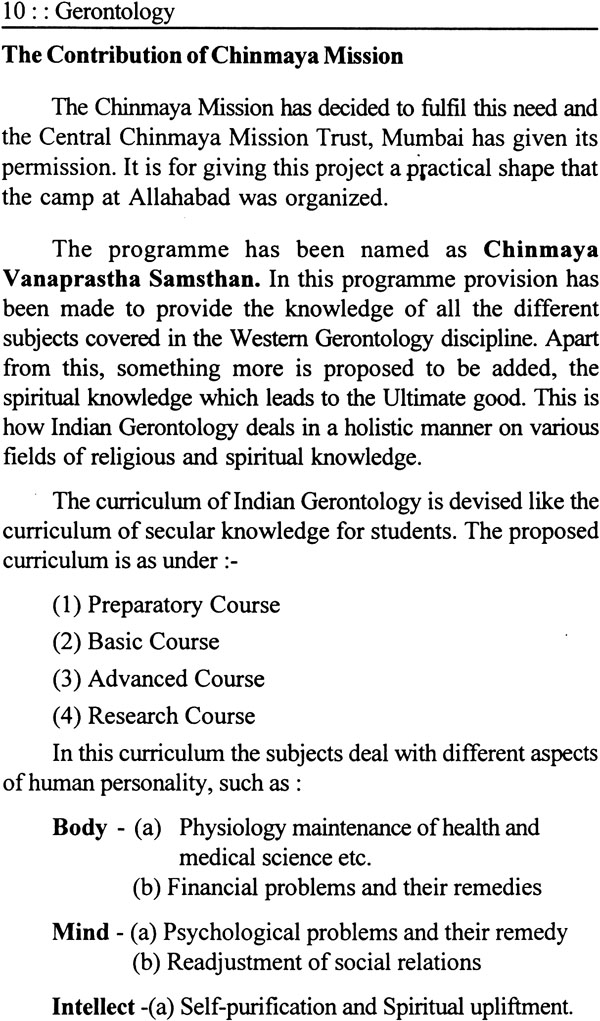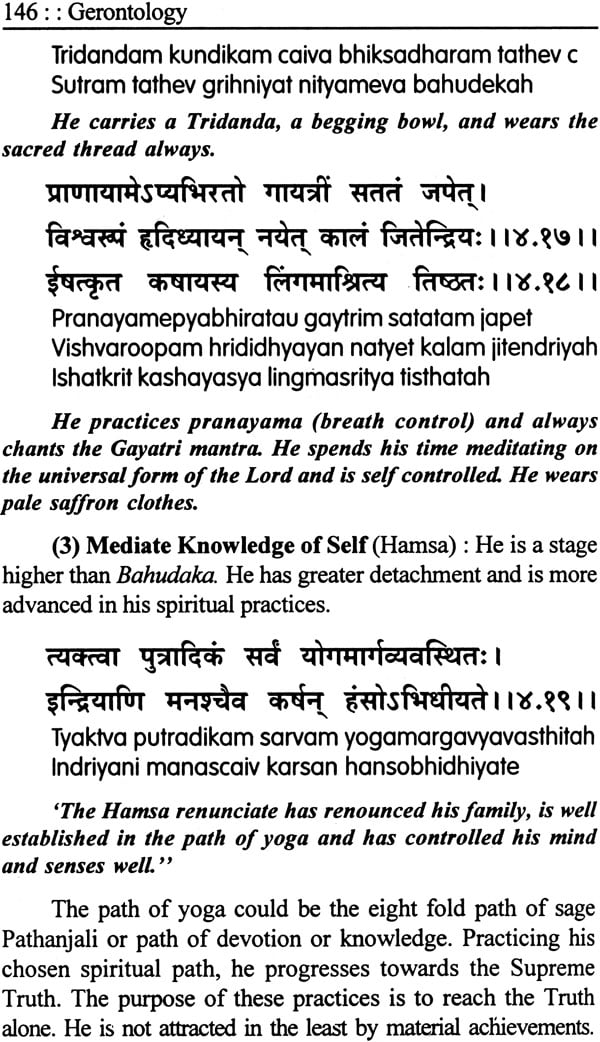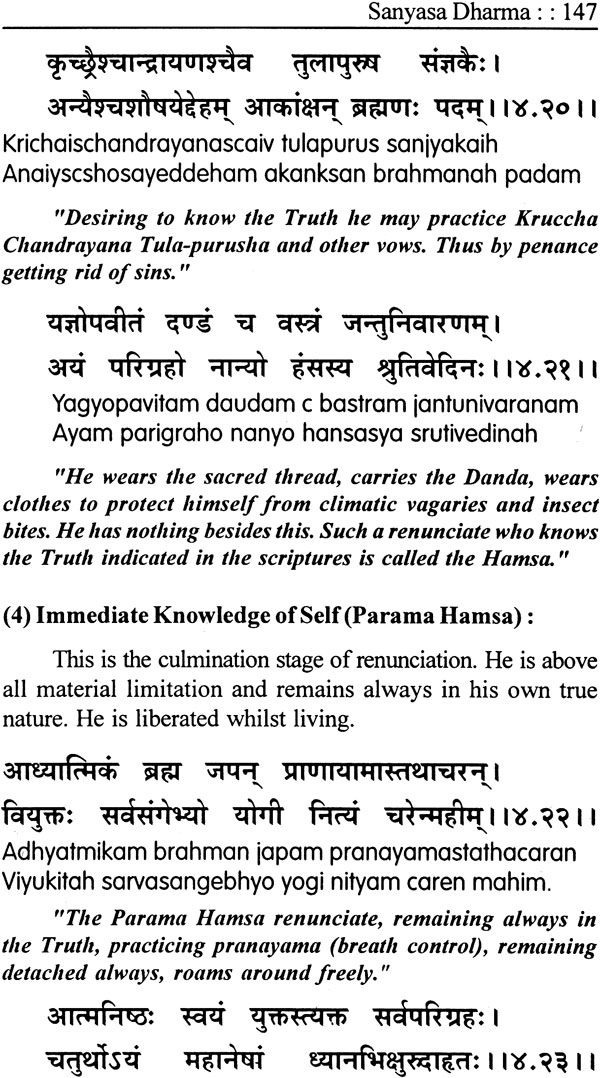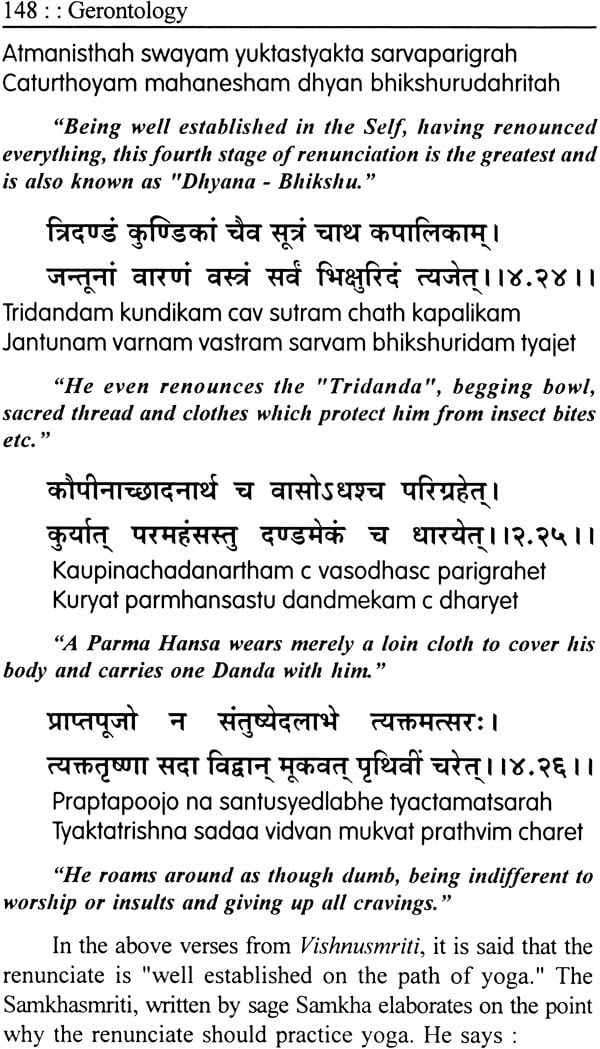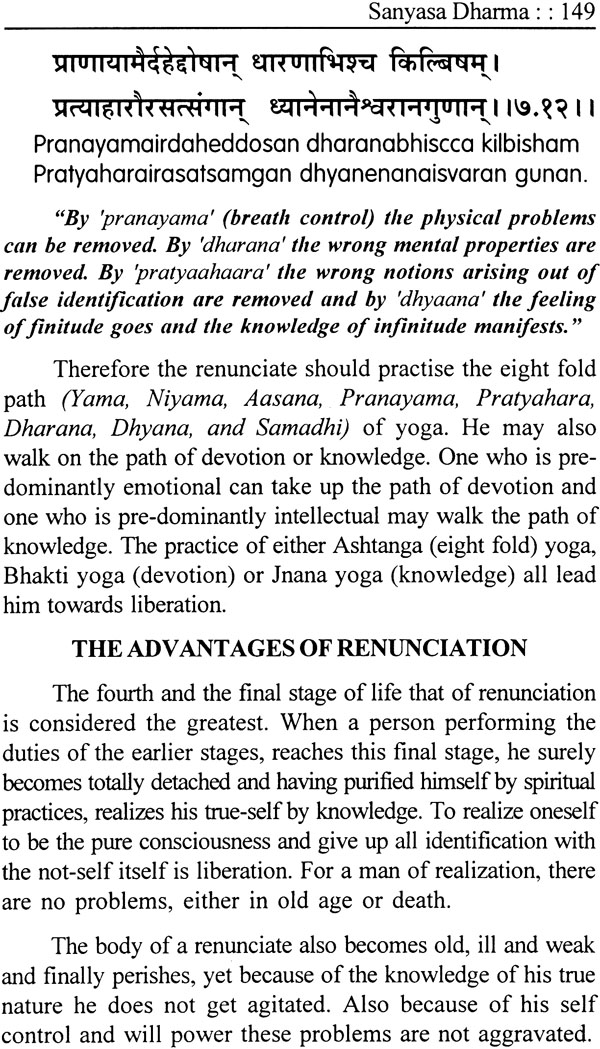
An Introduction to Gerontology
Book Specification
| Item Code: | IDJ699 |
| Author: | Swami Shankarananda |
| Publisher: | Central Chinmaya Mission Trust |
| Language: | English |
| Edition: | 2004 |
| ISBN: | 8175971649 |
| Pages: | 151 |
| Cover: | Paperback |
| Other Details | 8.4" X 5.4" |
| Weight | 180 gm |
Book Description
Preface
Hindi Version of 'An Introduction to Gerontology' was published in 1996 with a view to solving the problems of Senior Citizens. Since then it is being distributed in Chinmaya Vanaprastha Sansthan (CVS) Camps all over the Chinmaya Mission Centres. It has been immensely liked by all and is accepted as a text book for Vanaprastha Sanstha.
Its popularity created a demand for its English version for persons not so comfortable in Hindi. We appreciated the need and wished to fulfil it.
Rao Ranbahadur Singh of Rewa and Swamini Vimalananda kindly came forward to translate the book. We are grateful to them and as a result of their labour the book is now in your hand in English version.
Introduction
Old age, also called Geriatic age, can be something more than a time of rest. It has its own utility and meaning. It is unfortunate that the society does not give any attention to it. Because of this the elder people today are not able to spend their life in joy and peace. In addition, the society is deprived of the good that they can do.
Poojya Gurudeva Swami Chinmayananda was well aware of this problem. He also had with him the remedy for it. Therefore he established many Pitamaha Sadans in different parts of India for the welfare and guidance of the elders. In them the elder citizens can find a place to live in comfort, get training, and improve themselves to make their life meaningful by serving society.
Under this scheme of Poojya Gurudeva recently a project of training elders has been initiated. It was first organized at Allahabad from 7th to 10th February 1996 and was called 'Vridhavastha Samadhan Shivir'. Dr. Sajjan Singh, Dr. A. P. Mathur and Swami Shankarananda addressed the participants and the gist of their talks is being presented in this booklet. It is hoped that the readers shall benefit by it and join this programme. They can correspond with the Manager.
Back of the Book
"Youth is a time for indulgence, old age for repentance." This saying can be disproved with a little bit of training and reorganizing.
Old people can lead a life of dignity. They can even become as precious as old coins and vintage cars. All it takes is a little of time-management and adjustment on their part. This book gives scientific and practical guidelines (based on scriptural texts) to help senior citizens become positive contributors to society.
To quote Pujya Gurudev, Swami Chinmayananda, "Old age need not be painful. Death may not be a frightening mystery. To learn to live in devotion and surrender to Him is possible (and is easier) in the days of retirement."
Pujya Swami Shankarandaji has painstakingly researched and aligned remedies for old age problems like loneliness, financial and emotional insecurities. Etc.
This book is a sure self-help book that will help all oldie-goldies ripen like sweet fruits with the juice of wisdom.
| Letter from Swami Chinmayananda | 5 | |
| Introduction | 6 | |
| 1 | Gerontology | |
| 1. What is Old Age? | 7 | |
| Percentage of elders in society. Solution of the problem. Indian efforts. Contribution of Chinmaya Mission. Categories of the elders. | ||
| 2. The Genesis and Development of Gerontology | 13 | |
| 2 | Old Age Hygiene | |
| 1. Aids to Good Health | 17 | |
| Exercise. Walking as an exercise, Yogasan, Other forms of Exercise. Healthy Food, Malnutrition, Sleep, Bath | ||
| 2. Eye Care | 24 | |
| Certain tips to keep the eyes healthy, eye diseases. What should we do when eye-sight becomes weak. Help to the people of less vision | ||
| 3. Deafness | 27 | |
| 4. Weakness of other senses | 28 | |
| 5. Breathlessness | 29 | |
| 6. Weakness of Bones | 30 | |
| 3 | Old Age Economics | |
| 1. The Dominance of Wealth | 31 | |
| Renouncing inner craving. The dominance of Spirituality | ||
| 2. Various Economics Groups | 35 | |
| The Rich. The Middle Class | ||
| The Poor, The Penniless | ||
| 3. Investment of Wealth | 37 | |
| Considerable points. Investment in shares. Investment of Deventures. Investment in Unit Trust, Investment in Banks. Investment in Real Estate Investment as per need. | ||
| 4. Evil aspects of money | 39 | |
| Looting of Wealth, Danger to life, Mental tension, Increase in pride, Obstacle to Spiritual practices. | ||
| 5. All the Wealth belongs to God. ? | 42 | |
| 6. Non-contact with wealth | 45 | |
| 7. Renouncing dependance on wealth | 46 | |
| 8. Method of Renouncing Wealth | 47 | |
| Reducing the needs. Simple food, Renouncing bad habits. Renouncing Menal Weaknesses. Acquiring good qualities. Service to Society Bliss of the Self | ||
| 4 | Old Age Psychology | |
| 1. Definition | 52 | |
| 2. History of Psychology | 53 | |
| 3. Modern Psychology | 54 | |
| 4. Relationship with other sciences | 55 | |
| 5. Methods of the study of Psychology | 57 | |
| 6. The Two Aspects of Psychology | 59 | |
| 7. Mental Differenses | 60 | |
| 8. Three Qualities of Nature | 61 | |
| 9. Mental Creation | 65 | |
| 10. Types of mental Creation | 68 | |
| 11. The Problems of Mental Creation | 69 | |
| 12. The mental Problems of Old Age | 70 | |
| The Body, Family, Economics Consideration. Fear of Death | 73 | |
| 13. Abnormality in Old age | 73 | |
| Irritability. Restlessness Anxiety | ||
| Sentimentality. Forgetfulness. Lack of | ||
| Confidence. Sleep. Non-adjustment. Worry Expectations | 79 | |
| 5 | Old Age Sociology | |
| 1. Definition | 81 | |
| 2. Society of the Aged | 82 | |
| 3. Status of Old People in Society | 84 | |
| 4. Ways of Life | 85 | |
| Professional Life. Part Time Business, Retired Life. Inactive and Aimless Life. Social Worker. Spiritual Life. | ||
| 5. Non-Conducive social environment | 87 | |
| 6. Family Problems | 88 | |
| 7. Meaningful utilisation of Old Age? | 93 | |
| 8. The All Important Duty | 96 | |
| 9. Social Organisation | 100 | |
| 10. Two Aspects of Duty | 104 | |
| 6 | Old Age Duties | |
| 1. Vanaprastha Duties | 110 | |
| Leave your Home. Study Scriptures. Go to your Master. Do your Duty. Detachment Abstinence. | ||
| 2. The Advantages of Vanaprastha Life | 123 | |
| No Health Problem. No Economics Problem. No Phychological Problem, No Social Problem. | ||
| 7 | Sanyasa Dharma | |
| 1. Renunciates | 134 | |
| Give up Fire. Leave Home. Life on alms. Indifference. Steadfast. Contemplation. Complete Renunciation. No fear of Death. Purity of Mind. Energy. Propagation of Self Knowledge. | ||
| 2. The Four types of Renunciates | 144 | |
| Living at home. Living on Alms. Hansa. Parama Hansa. | ||
| 3. The Advantages of Renunciation | 149 |
